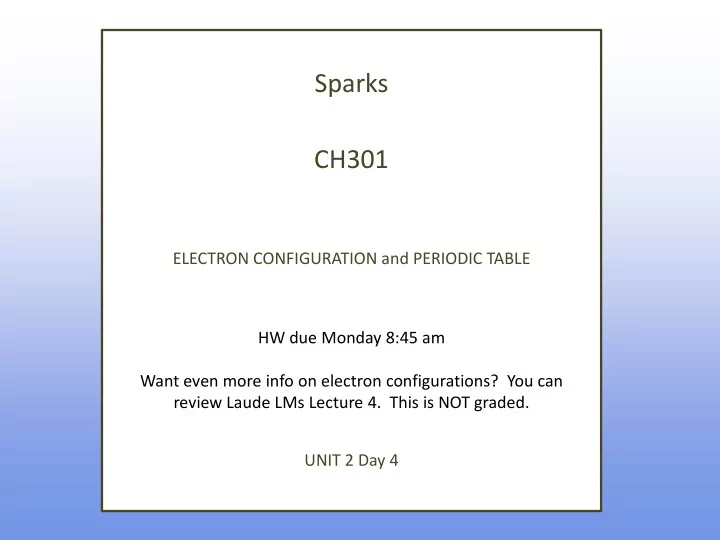

Sparks CH301 ELECTRON CONFIGURATION and PERIODIC TABLE HW due Monday 8:45 am Want even more info on electron configurations? You can review Laude LMs Lecture 4. This is NOT graded. UNIT 2 Day 4
WHAT DO YOU THINK? When I’ m studying chemistry, I spend my time learning the new material and… A) That is it until the next exam comes along. B) Reviewing what I already understand. C) Focusing on what I do NOT understand. D) Splitting up time between reviewing what I already understand and focusing on what I do NOT understand.
How to learn effectively: Identify what you do & don ’ t understand Highlight what you don ’ t understand within your notes plus in-class problems Practice more on what you don ’ t understand How Learning Works by Ambrose et al (2011)
What are we going to learn today? Apply the Theoretical Model (QM view) • Relate empirical model to the theoretical model for atoms with more than one electron • Understand the powerful, predictive nature of the model • Relate the predicted ground state electron configurations with position on the periodic table • Relate electron configuration with periodic trends
QUIZ: CLICKER QUESTION The solutions to the Schrodinger Equation yield solutions that provide information about: a) Energy of electrons b) Probability of finding electrons in certain regions in space c) Both a and b d) Neither a or b
QUIZ: CLICKER QUESTION Which of the following is not a valid set of quantum numbers for the wave function for an electron in a hydrogen atom? A.n=1, l=0, m=0 B.n=2, l=2, m=1 C.n=2, l=1,m=-1 D.n=3, l=2, m=0
Electron Configurations
• AUFBAU PRINCIPLE: Means “building up”. Start at the lowest energy orbital, fill it (always obeying Pauli’s exclusion principle!) and work up.
Periodic Table helps to determine order of orbital filling for elements, use table to predict electron configuration of Al Know names for groups 1A, 2A, 7A, 8A. Also know where the transition metals are.
HUND’S RULE • For a set of degenerate* orbitals, the lowest- energy configuration of an atom has the maximum number of unpaired electrons. *degenerate: same energy • In other words, electrons occupy degenerate orbitals singly before doubling up.
Figure 12.33: Radial distribution of electron probability density for the Na atom. the closer the negative electron to the positive nucleus, the stronger the electrostatic attraction.. and the lower the energy. An electron in a 3s orbital will be closer (on average) to the nucleus than if in any 3p orbital. An electron in any 3d orbital spends even less time near the nucleus. So the 3s orbital fills first, then the 3p’s.. what next?
Figure 12.34: Radial probability distributions for 3d and 4s in Na
PRACTICE IDENTIFYING QUANTUM NUMBERS AND ELECTRON CONFIGURATIONS CLASS GROUP WORK, pages 39-42
A FEW QUESTIONS RELATING TO THE WORKSHEET
What have we learned? THE CONNECTION BETWEEN QUANTUM NUMBERS AND ELECTRON CONFIGURATIONS THE ORDERING OF ENERGY LEVELS IS GENERALLY THE SAME FOR ATOMS FOR ALL ELEMENTS
Learning Outcomes Describe the difference between one electron systems and multi-electron systems. Predict electron configurations based on position on periodic table. Apply the Aufbau principle to determine the configuration for any atom or ion. Use Hund ’ s Rule to determine electron configuration using an orbital diagram (electrons in individual orbitals with spins. Students will use the shell model of multi-electron atoms to describe the concept of core vs. valence electrons
Recommend
More recommend